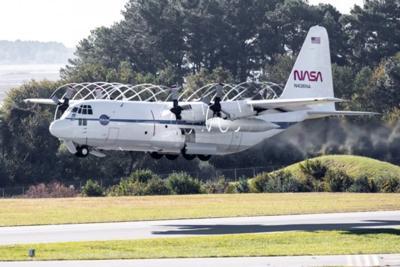Flight Supports NASA’s GUSTO Balloon Mission
On 28 October 2023, following a grueling journey undertaken for purpose of delivering NASA’s Galactic/Extragalactic ULDB Spectroscopic Terahertz Observatory (GUSTO), the space agency’s C-130 Hercules touched down safely at McMurdo Station on the southern tip of Antarctica’s Ross Island.

A United States research station, McMurdo is operated by the National Science Foundation and hosts NASA’s Antarctic long-duration balloon campaign, via which the GUSTO mission will take a scientific balloon flight beginning December 2023.
The C-130 crew, which has now completed half of a planned 26,400-nautical-mile round-the-world journey, first stopped at Fort Cavazos, Texas, on 17 October to load the GUSTO observatory and members of the GUSTO team. Additional stops to service the aircraft and rest its crew were made at California’s Travis Air Force Base (AFB), Hawaii’s Hickman Air Force Base, American Samoa’s Pago Pago International Airport (PPG), and New Zealand’s Christchurch Airport (CHC). Finally the aircraft and its weary crew landed at McMurdo Station, a scant 695-nautical-miles from the Earth’s south pole.
A facet of NASA’s Astrophysics Explorers Program, GUSTO is slated to fly aboard a football-stadium-sized, zero-pressure scientific balloon on a 55-day mapping mission of a portion of the Milky Way Galaxy and the nearby Large Magellanic Cloud—a satellite galaxy of our own Milky Way and only approximately one-hundredth the mass thereof.
A telescope with constituent carbon, oxygen, and nitrogen emission line detectors will measure the interstellar medium, the cosmic material found between stars, and trace the full lifecycle of that erudite matter. GUSTO’s scientific observations will be performed from a balloon gondola insomuch as lighter-than-air ships are the only atmospheric aircraft capable of remaining aloft for the protracted periods of time required to make accurate astronomical observations. Also, the long Southern Hemisphere summer days in the vicinity of the South Pole afford the GUSTO ample solar energy for the production of electricity.

NASA’s Wallops Flight Facility Aircraft Office in Wallops Island, Virginia, which manages the C-130, spent nearly a year preparing for GUSTO’s trip to its Antarctic launch site—the mighty aircraft’s first-ever mission to the world’s icy bottom. The trip occasioned numerous challenges, as recounted by Wallops and GUSTO mission pilot John Baycura, who stated: “We work very hard to make sure that we execute the mission at a high standard of technical competence and professionalism to maintain NASA’s international reputation.”
Dramatic time-zone changes challenged the crew’s circadian rhythm. Ninety hours in flight across multiple time zones required the GUSTO flight to be manned by an extra pilot and flight engineer. Mandatory crew rest days at strategic locations ensured the crew received sufficient recuperative time.
No commercial air-carriers supported the final leg of the flight to Antarctica. The USAF C-17s and Air National Guard LC-130s ordinarily tasked with making flights to McMurdo hadn’t enough time on their respective schedules to accommodate the transport of the GUSTO equipment. Ergo, NASA’s C-130 was called into action for the specialized cargo mission.
Mr. Baycura remarked: “The balloon program gained a dedicated asset with a highly experienced crew and support team. This greatly reduced the standard project risks to schedule, cargo, and cost.”
 ANN's Daily Aero-Linx (04.30.25)
ANN's Daily Aero-Linx (04.30.25) ANN FAQ: Turn On Post Notifications
ANN FAQ: Turn On Post Notifications Classic Aero-TV: Agile Aeros Jeff Greason--Disruptive Aerospace Innovations
Classic Aero-TV: Agile Aeros Jeff Greason--Disruptive Aerospace Innovations Aero-News: Quote of the Day (04.30.25)
Aero-News: Quote of the Day (04.30.25) ANN's Daily Aero-Term (04.30.25): Expedite
ANN's Daily Aero-Term (04.30.25): Expedite




